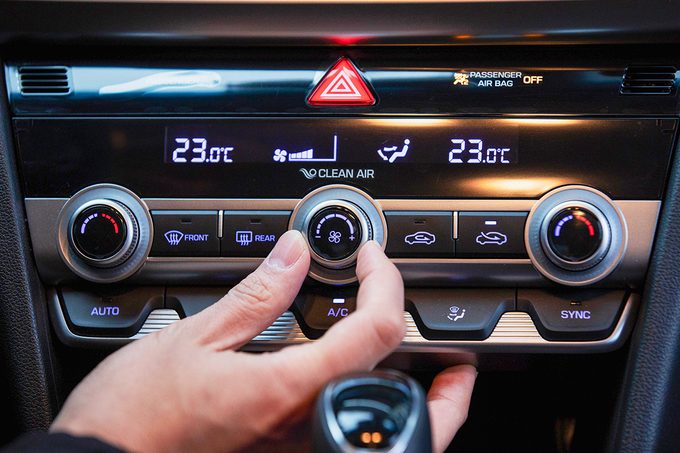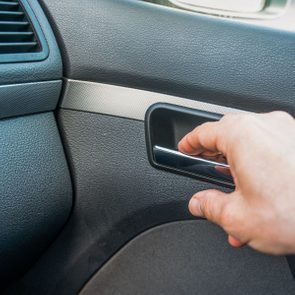Hint: It's not the A/C alone—it's how you use it

Here’s the Simple Trick to Cooling Off Your Car as Quickly as Possible

There’s hot, and then there’s parked-car-in-the-summer-sun hot. You know, the kind of blaze that makes your seat greet you like a stovetop and even your sunglasses feel betrayed.
But here’s the good news: There’s a smarter way to cool things down—no frantic fanning or open-door flailing required. According to expert Julie Bausch Lent, managing editor of CarTalk.com, the digital content iteration of the long-running NPR show about all things automotive, most drivers miss one simple step that can make a big difference.
Read on to find out how to help your car’s A/C help you when you need it the most.
Get Reader’s Digest’s Read Up newsletter for more car news, humor, travel, tech and fun facts all week long.
What’s the trick for cooling your car down quickly?

It all comes down to a feature on your dashboard that you’ve probably ignored: the air recirculation button. “Most people don’t even know what it does,” says Bausch Lent. “When you hit that button, your car stops pulling in hot air from the outside and starts re-cooling the air already inside your cabin.”
It sounds simple. But used correctly, it can make a dramatic difference. The key is timing. If you hit the button the moment you get in—when the cabin is still blazing—you’re just recirculating that hot air. Your A/C ends up working harder, not smarter. The better move? Roll down your windows first (yes, all of them), start driving and give that trapped heat a chance to escape.
Just don’t leave recirculation mode on all day; it’s designed for short bursts, not long hauls.
Why does the recirculation button cool things faster?
It gives your A/C a serious head start. Instead of pulling in scorching hot air from outside, your system works with air that’s already been cooled, essentially looping it through again and again, which takes far less effort. The result is a faster cooldown and a less taxed system.
It also makes a difference to your engine and gas mileage. On brutally hot days, your A/C has to work harder to cool outdoor air, which means your engine has to work harder too, especially in older cars. Using the recirculation feature once the cabin has cooled a bit takes that extra load off.
Most newer cars have an automatic mode that turns recirculation on and off as needed. If your car has it, trust it. Just know that in extreme heat, a little manual intervention can help things along.
How to use your air circulation button for maximum cooldown
Step 1: Let the heat escape
Before you even touch that recirculation button, roll down all your windows and drive for a minute or two. “You’ve got to get the stagnant hot air out first,” says Bausch Lent. “Otherwise, you’re just recirculating sauna air.”
Step 2: Crank the A/C
With the hot air gone, blast your A/C on high.
Step 3: Now hit recirculate
Once the air feels noticeably cooler, press the button. Your A/C will cool the cabin air more efficiently, and your engine won’t have to work as hard.
What other times should you use the air recirculation button?
This button isn’t just for heat relief. It can also improve your car interior’s air quality in specific situations:
In heavy traffic
Stuck behind a line of idling vehicles or a smoky truck? “Outside air is full of exhaust and particulates,” Bausch Lent says. “Recirculating helps keep those pollutants out of your lungs.”
When passing through funky air zones
If you’re driving past freshly fertilized fields, construction dust or clouds of pollen, recirculating the air can tone down smells and allergens.
When should you avoid hitting the air recirculation button?
Think of the recirculation button like a good perfume: best when used in moderation.
Using it nonstop, especially on long drives with a full car of passengers, can lead to a buildup of carbon dioxide inside the car, making you feel drowsy or dizzy. It can also trap moisture, especially in humid or wintry weather, which over time could lead to foggy windows or mold in your ventilation system.
“Your car’s air system needs a chance to breathe,” says Bausch Lent. “That means cracking the windows, switching the setting off periodically and letting in fresh air.”
How else can you keep your car cool in summer?
Even without tech upgrades, a few simple tricks can drop the temp:
-
Park in the shade. Obvious, yes, but it works. Even if it means walking a bit farther, parking in the shade can mean a 30- to 40-degree difference.
-
Use a sunshade. Yes, they’re awkward to fold. But they help block direct rays and protect your interior from baking.
-
Remote start. Starting your car 5 to 10 minutes before you get in gives your A/C a head start—and your body a break.
-
Point vents strategically. No back-seat vents? Aim your front vents toward the ceiling to circulate air more evenly. Have pets or kids riding along? Make sure the airflow gets to them too.
What about leather seats and tinted windows?
Leather looks sleek, but it gets hot. If your car has dark or leather upholstery, toss on a cloth seat cover in the summer months. For a bigger investment, ceramic window tint can also reduce heat, though state laws on window tinting vary.
It might not get top billing on your dashboard, but the recirculation button can seriously cut the heat when it’s used wisely. Pair it with a good breeze, a little timing and a few smart habits, and you’ve got a cooler ride before your sunglasses even slide off your nose.
RELATED:
- This Is the Real Reason Cars Have Lines on the Rear Windshield
- Here’s the Sneaky New Trick Thieves Are Using to Break into Locked Cars—Yours Could Be at Risk If You Don’t Do This
- This Hidden Smartphone Feature Could Prevent Thousands of Car Crashes, Yet 85% of People Don’t Know How to Use It
About the expert
|
Why trust us
At Reader’s Digest, we’re committed to producing high-quality content by writers with expertise and experience in their field in consultation with relevant, qualified experts. We rely on reputable primary sources, including government and professional organizations and academic institutions as well as our writers’ personal experiences where appropriate. We verify all facts and data, back them with credible sourcing and revisit them over time to ensure they remain accurate and up to date. Read more about our team, our contributors and our editorial policies.
Source:
- Julie Bausch Lent, managing editor of CarTalk.com; interview, July 2025



